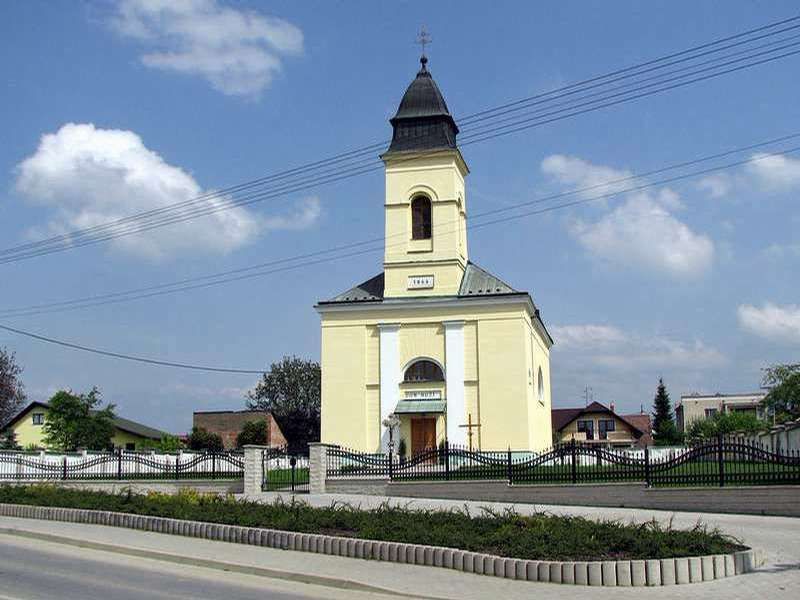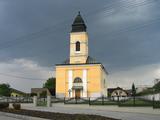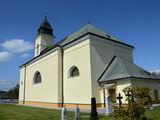Žilina Gallery
» Mesto Žilina » História a archeológia » Pamiatky – QR kódy » Pamiatky QR kódy II » 78 Kostol sv. Imricha
4/7
78 Church of St. Imrich (EN)

78 – Church of St. Imrich in Bytčica, Hlavná Street 14
Turistická informačná tabuľka č. 78 s QR kódom na Kostol sv. Imricha v Bytčici(Foto: 27. 5. 2007)
St. Imrich Church is Classical in style and dates from 1844. It has a single thin vaulted Czech nave and a flat vaulted Prussian chancel. The windows on the north and south sides are Diocletian and the facades are divided by pilasters with cornice heads, running down from the ceiling cornice. Above the entranceway on the main facade there is a Diocletian window between flat pilasters, incorporated into the recess and disaggregated by a rusticated band, and above it there is a crowning cornice with tower. The main altar is Classical and was built in the mid-19th century. On the Classical painted illusionary wall is a canvas painting of St. Imrich. The pulpit also dates from the mid-19th century. It features a picture of the Good Shepherd. There is a Classical wooden baptismal font dating from the mid-19th century as well. In the church there is also a mid-19th century stone stoup. A wall painting depicts the main altar of St. Imrich and canvas oil painting on the shrine wall depicts illusionary architecture. In the middle there is a painting of St. Imrich kneeling in front of a statue of the Virgin Mary.
Bytčica is located in the south of Žilina and the first records date from 1409, when it was called Bytzycz. It was part of the Lietava estate, which had extensive gardens in the village. The locals mainly lived off the land, farming sheep and keeping bees. There are also two mansions - a three-storey baroque mansion dating from the 18th century and a second Classical mansion dating from the mid-19th century. There is also a former mid-19th century manor.
Romuald Čelislav Zaymus lived in Bytčica for nearly 40 years. He came from Rajec, where he was born on 7 February 1828. After studying philosophy and theology in Vacov, Budín and Nitra, he worked as a chaplain in Močenok, Košeca, Lednica, Beluša, Vysoká nad Kysucou, Ilava. From 1863 until he died on 19th July 1902 he was just an ordinary priest in Bytčica. In addition to his pastoral work he was particularly interested in supporting Slovak national awareness and efforts at emancipation. He was in favour of Martin Hatala’s reforms of Slovak grammar. He co-founded Matica Slovenská and was also head of the organisation in Trenčín Region. He worked mainly in the natural sciences and geology department of Matica Slovenská and helped establish the first Slovak grammar school in Kláštor pod Znievom. He was a member of the Committee of the St. Vojtech Society and was also vice president of the Slovak Museum Society. He was frequently persecuted and imprisoned for his activities. He campaigned against alcoholism by establishing sobriety associations, but also turned his attention to soil cultivation, botany and pomology. He planted orchards in Bytčica, Ilava, and Lednici, and tree nurseries in Beluša, Vysoká nad Kysucou, Rajec, Košeca, and Turzovka. He introduced new types of crops, grew flowers and vines. He also farmed livestock, fished, kept bees, and cultivated potatoes. At a show in Žilina in 1878 he exhibited 35 kinds of potatoes. He published a monthly entitled Horizon and contributed pieces to Cyril and Methodius, Friend of school and literature, and The Christian. He sent articles to National Newspaper and The People’s Newspaper. His most significant work includes: Past and present of people from Upper Trenčín (1893); Political parties in Hungary (1897); Notes on historical, religious and memorable items in Trenčín (1900). His historical articles were published mainly in the Compendium of Slovak Museum Society and in Journeywork. He took over the editing of Horizon, providing news on economics, craft and home life (1882-1886) after the death of Daniel Lichard. A street in the centre of Žilina and an elementary church school in Žilina now bear the name Romuald Čestislava Zaymus. At the parish office building in Bytčica there is a plaque with a portrait of R Zaymus with the words: Here lived and performed ROM. Č. Zaymus 5.II.1828 +19.7.1902 National revivalist. His name will always be associated with Bytčica.
Source: Mgr. Jozef Moravčík. Text prevzatý z webovej stránky TIK Žilina (kliknite): www.tikzilina.eu.
preberanie textov a obrázkov bez zvolenia autora je striktne zakázané
Site Map
Powered by PhpWebGallery
Site Map
Powered by PhpWebGallery


[0] Komentárov